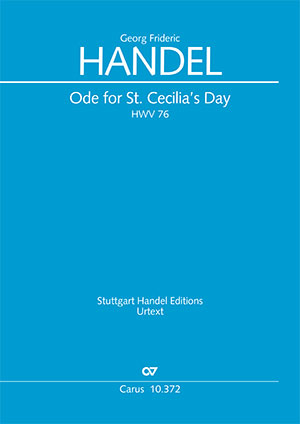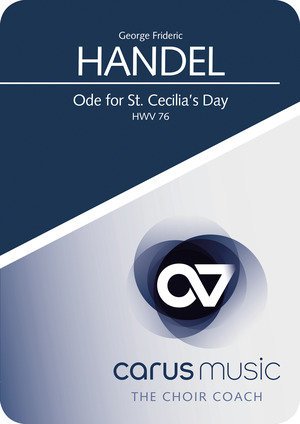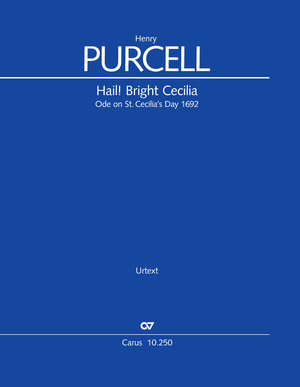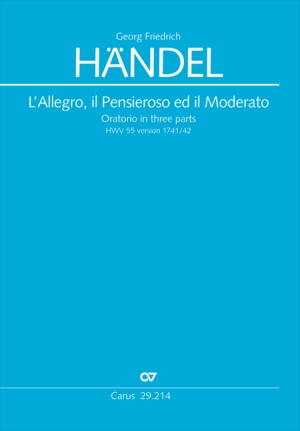
Contents
-
Composer
Georg Friedrich Händel
| 1685-1759George Frideric Handel put his exceptionally versatile compositional abilities to the test at an early age. After moving to London in 1712, where he was appointed Composer of Musick for His Majesty’s Chapel Royal in 1723, he wrote numerous masterpieces for the royal court as well as his major opere serie. For many years he enjoyed triumphant successes with his operas, which were sung by outstanding performers, with serenades, and later also with oratorios such as Saul and Israel in Egypt. Over the years Handel’s reputation grew far beyond the city where he worked; some of his choral works, particularly Messiah, have enjoyed a performance tradition which remains unbroken to this day, and are sung by choirs throughout the world. Personal details
-
Editor
Christine Martin
-
Songwriter / Librettist
John Dryden
-
Vocal score arranger
Paul Horn
| 1922-2016Paul Horn war ein deutscher Kirchenmusiker, Organist, Komponist und Musikwissenschaftler. Er studierte Kirchenmusik und Orgel an der Evangelischen Kirchenmusikschule Esslingen am Neckar bei Hans-Arnold Metzger und Musikwissenschaft, Theologie und Geschichte an der Universität Tübingen. Seine berufliche Laufbahn begann als Kantor an der Evangelischen Michaelskirche in Stuttgart-Degerloch. 1954 wurde er Kantor an der Evangelischen Stadtkirche Ravensburg, eine Position, die er bis zu seiner Pensionierung innehatte. Als Musikwissenschaftler arbeitete Horn bis ins hohe Alter eng mit Carus zusammen. So stammen zahlreiche Carus-Klavierauszüge aus seiner Feder. Personal details
Reviews
Georg Friedrich Händel: Ode for St
Georg Friedrich Händel: Ode for St. Cecilia’s Day (HWV 76)
Im Rahmen seiner Stuttgarter Händel-Ausgaben legt der Carus-Verlag nun die Cäcilienode des Jahres 1739 auf einen Text von John Dryden (engl.) vor. Neben den für Händel bezeichnenden festlichen Chören besticht das dreizehnteilige Werk durch ungewöhnlich phantasievolle Instrumentierung der Soloarien. Das Werk ist sicherlich einmal eine Alternative zum ewigen Dauerbrenner Messias, nur leider wohl nicht abendfüllend.
Wilfried Rombach
Quelle: Kirchenmusikalische Mitteilungen 10/2004
I can still remember the impression made on me when, I suppose about 45 years ago, I bought a World Record Club disc of this and was bowled over by the alternating soprano solo and choral chorale that begins the final chorus ? luckily I don‚t still have the disc, since I suspect that I‚d now find that Teresa Stich-Randall‚s voice lacked the precision of the trumpet fanfare that arose under her final top A. I don‚t remember ever hearing a live performance, their rarity perhaps being because of the lack of decent orchestral material (though the Kalmus set isn‚t as bad as usual). We were thinking of doing a set ourselves during the next few months, but that has been made unnecessary by this fine new edition from Carus. As well as the full score, the vocal score is already available (10.372/03; ?14.00, about £9.5o) and parts are promised in a couple of months. There are two obvious editorial decisions to be made. One is the title. As with Purcell‚s Hail, bright Cecilia, the term Ode refers to the form of the poem, while the musical term is Song. Handel‚s autograph is headed Ouverture to the Song for St Cecilia‚s Day by Mr Dryden 1687, and the first two editions of the work have the usual title for selected solos, Songs from/in continued with the word Ode referring to the poem: in the Ode wrote by Mr Dryden for St. Cecilia‚s Day Set by Mr Handel. In the first full score (1771) the title is more ambiguous: The Complete Score of the Ode... Set to Music by Mr Handel. HWV uses the opening line ‚From Harmony, from heav‚nly Harmony‚ as the main title, but undermines it by having Ode for St. Cecilia‚s Day as the running heading for the relevant pages. Modern usage should probably be either the first line or Dryden‚s Ode...
The other problem is what to do with the minuets that end the Ouverture. The autograph has one in D minor followed by another in D major, with the D-minor one crossed out. The Ouverture is missing from the conducting score. I haven‚t had a chance to check the early sources, but it is curious that the three pre-Chrysander editions I have (Arnold c.1792, The Handel Society, 1844-5, and Vincent Novello‚s vocal score from the 1850s) all have the related Minuet in D major that Handel used to end op. 6/5 (whose first two movements are taken from the Overture to the St Cecilia‚s Day Song). I would guess this to have been normal 18th-century manner of performance. The Carus edition ignores Handel‚s deletion, reverses the MS order, and prints them as Minuet and Trio, not Handel‚s normal treatment when minuets end overtures. I‚d be happier if the suggestion were footnoted, not buried in the commentary. The editor misses that in the D major Minuet, the middle line is allocated to violin 3 as well as viola: at least, that‚s how it reads to me, both on the facsimile in the edition and on my microfilm.
Were this a thorough critical edition, I would expect a slightly more precise commentary. I can‚t see on my film, for instance, the words Liuto and Org. at bar 39 of No. 7, although as suggestions they are sensible enough. But I have no hesitation in recommending this to customers. It is good value (about £22), clearly readable, with no cluttering German translation underlaid; instead, the poem is printed the introduction with a German version alongside.
Quelle: Early Music Review, 4/04, S.3
Frequent questions about this work
 There are no questions and answers available so far or you were unable to find an answer to your specific question about this work? Then click here and send your specific questions to our Customer Services!
There are no questions and answers available so far or you were unable to find an answer to your specific question about this work? Then click here and send your specific questions to our Customer Services!









